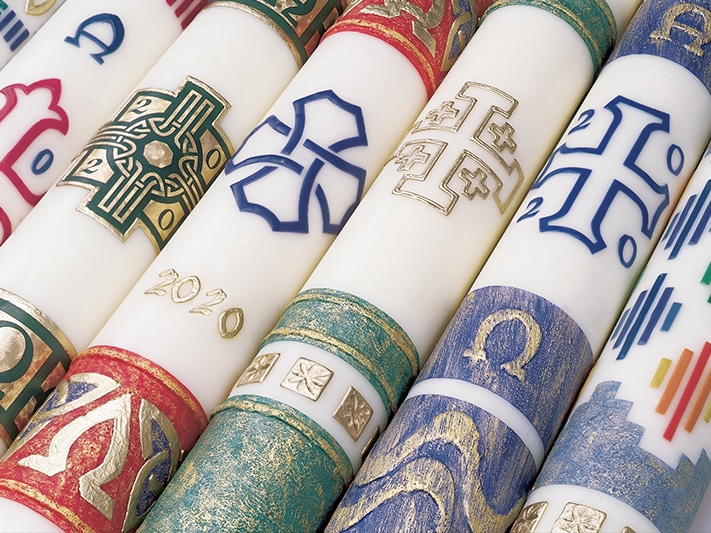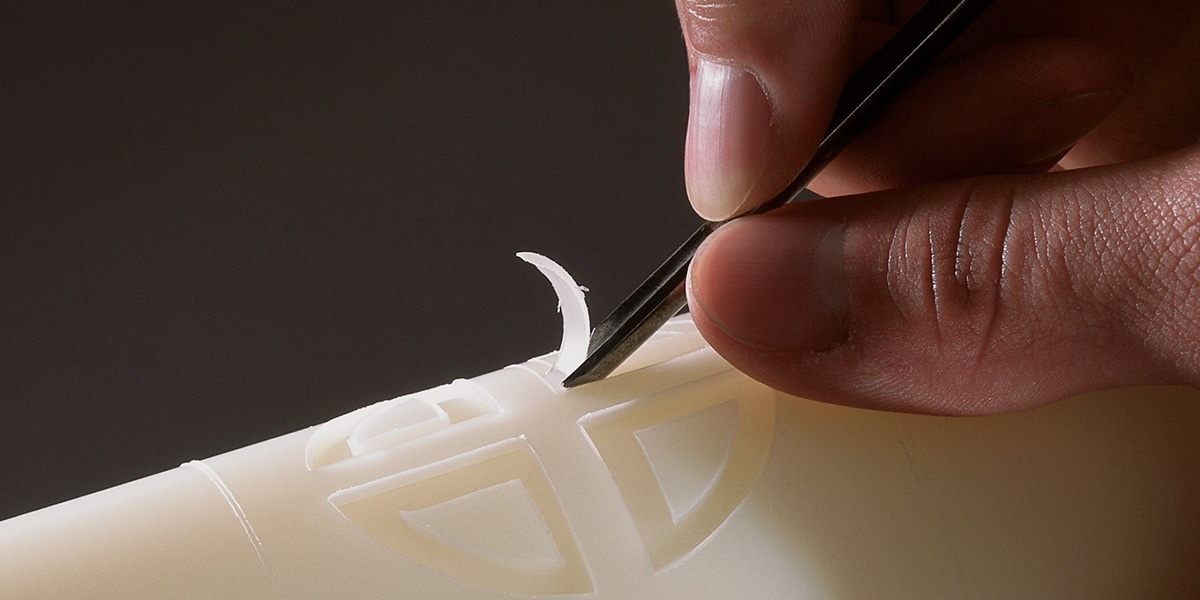This month, parishes across the country will light their paschal candles before the Easter Vigil on Holy Saturday. Chances are, some of them were made by this self-taught candlemaker.
If you are looking for Martin Marklin, you will likely find him in one of two places—either tending to the 100-150 beehives on his farm in New Hampshire or handcrafting candles made from the fruits of those bees’ labor. That is because, for Martin, the two are spiritually connected.
Martin is the founder and owner of Marklin Candle Design (MarklinCandle.com), which makes liturgical candles for churches throughout the world. The company has also made candles for four papal visits—two by St. John Paul II and one each for Popes Benedict XVI and Francis—and has expanded into making liturgical furnishings. The present company is a far cry, though, from the small operation Martin started in his parents’ basement in the mid-’80s.
Humble Roots
Martin, who grew up in St. Louis, Missouri, was named after Monsignor Martin Hellriegel, pastor of Holy Cross Church, the Marklin family’s parish. The priest was a forerunner to the Catholic Liturgical Movement in the United States prior to Vatican II, so Martin says the parish “was a hotbed of liturgical renewal.”
As an altar server, Martin says he became fascinated with the liturgical candles he saw in the church. He recalls that every year, a couple in the parish would hand-decorate the paschal candle—carving out intricate and beautiful designs and filling them with melted colored wax. Martin says he remembers observing these candles and being mystified by how this technique was accomplished.
At the age of 13, Martin went off to the seminary in Hays, Kansas, to become a Capuchin Franciscan. When he returned home for Easter, he saw a less-than-beautiful paschal candle standing in the church. When he asked why, he was told that the couple who always provided the beautiful candles were no longer doing it, and no one else knew how.
Martin says he told Sister Mary Grace, “You get me a plain candle when I come home for Christmas, and I’ll decorate the candle and try to replicate the process.” And that’s exactly what he did—in his parents’ kitchen.
The kitchen, he says, “was a mess. It took my mom years to forgive me for all the melted colored wax I had on her stove.” From that moment on, Martin continued to refine his skills, and he developed a technique where he could make the candles proficiently and artistically. After he “built a workbench, got a couple beakers and a hot pot,” he moved production of his candles into his parents’ basement in 1985.
Marklin Candles Is Born
In the first year of his candlemaking business, Martin sold only six candles. He would go door-to-door trying to make sales. By the time his company’s third anniversary rolled around, he was up to 35 candles. Sales continued to grow steadily each year, going from 75 candles in the fourth year to 150 in his fifth year of business.
He started attending trade shows and tapped into the liturgical renewal in the United States. His numbers kept growing. Eventually, he moved his one-man business to New Hampshire where, in 1989, he met his future wife, Christine. She was teaching at the time, but it wouldn’t be long before she joined Martin in the candlemaking business.
Christine says watching Martin decorate the candles was always fascinating; that’s how she eventually picked up the skill. In fact, she decorated her first candle when Martin left the room to take a phone call.
“I sat down and finished it. He came back and said, ‘Wait a minute, I didn’t finish this one.’ I learned how to decorate the candles basically from spending a lot of time watching him. Then I eventually started helping decorate,” she says.

Christine left teaching and joined Martin in working full-time on the business, which has proven invaluable. In addition to their candle business, the Marklins also have a retail store, make church furniture, and manage 14 acres of land, which is home to an array of animals.
The couple have four children—Matthias, Judith, Simeon, and Anna—ranging in age from 20 to 26, who have all helped with the business at some time or another. But Christine is clear that while she and Martin love working with their kids, they are not “putting any pressure on them to come take over the family business.”
The Marklins have 15‚ 20 employees who help with many aspects of the business, but Christine points out that they still “have more than enough to keep us busy.”
But being busy didn’t stop Martin from taking on one more thing.
A Life-Changing Discovery
Marklin Candles are made using 51 percent beeswax, which equates to the company using about 30,000 pounds of beeswax a year. As Martin says in a video on the company’s website, that means “1.5 billion bees are working in the world for Marklin Candle.” Yet it wasn’t until about 11 years ago that Martin realized just how little he knew about how the wax he was using was created.
“How did these bees make wax, which was the source of our livelihood for all these years?” Martin asked himself. “I would be embarrassed if someone asked me about that.”
At that very time, a priest friend who was a beekeeper told Martin he should get into it. Martin took up the hobby, deciding it was “a good time for a midlife crisis,” he says with a laugh. The hobby, however, has been life-changing for him. “This one singular creature has transformed how I choose to live my life, how I try to operate our business. It really has pervaded many aspects of my life—in virtue of the facts of sustainability, stewardship of creation, living in community, and social justice,” says Martin.
The phrase be the bee, Martin says, is a good directive for us all to follow. The honeybee, he says, has much to teach us about community and serving others.
“When you think of a bee as a forager, what does it do? It seeks in the world that which is fragrant, colorful, beautiful, and she visits those flowers and ingests the nectar, adds some enzymes to it, and makes honey. And the analogy is that we similarly should be like the bee. We should be in the world, seeking out that which is beautiful, noble, true; and we should be, in our own lives, transforming it. But not for our own personal enrichment, because everything about a bee is for the society. The honeybee is a social creature and cannot live by itself.”
A Work of Faith and Art
That sense of community is something that Martin has instilled in his business too. Marklin Candle Design’s tagline is “The Mark of Human Hands,” which Martin says the company takes very seriously. “Of the seven companies in the United States that make candles for churches, we believe we’re the only ones who make the candles entirely by hand—hand-molded, hand-dipped, and hand-decorated. Every candle that goes from our door always has multiple hands that touch it along the way. That’s not only important but significant, particularly in light of the fact that these candles are going to be used in a liturgical service.”
The company also makes candles to mark births, deaths, and Baptisms, as well as other significant life events. Because of the personal nature of many of these products, Christine says workers end up working directly with the customer. In doing so, workers often get the story behind the candle, she says. Sometimes those stories are delightful, but other times they are heartbreaking. Oftentimes, she says, she ends up saying a prayer for the person or the family, “so it does really become a ministry.”
Paschal candles are also a mainstay of the company’s workload. The paschal candle is lit every year before the Easter Vigil and remains lit in the sanctuary of the church until Pentecost. It is a symbol of the light of Christ.
Usually, Martin says, paschal candles are decorated with the following elements: a cross, the alpha and the omega, the date, and five wax nails. Over time, though, he says the Church has provided artists with a bit more license regarding the design of the candles, which he sees as a bit of “a return to the days when the Church was a patron of the artist and would commission works of art.”
Martin says the words of the US bishops’ document “Built of Living Stones” form his thinking about how his company goes about creating their candles. The document notes, “Quality is evident in the honesty and genuineness of the materials that are used, the nobility of the form embodied in them, the love and care that goes into the creation of a work of art, and the personal stamp of the artist whose special gift produces a harmonious whole, a well-crafted work.”
Go Light Your Candle
Martin says candles play an important role in all of our lives, not just his. For instance, he asks, “When do we light candles?” and then runs down a list of the many ways we use candles—birthdays, deaths, peace marches, candlelight dinners, roadside memorials, even the Olympic flame.
“We have this very strong relationship between candles and light and flame and significant moments in our life,” he says. “Put that in the context of our faith, and that candle takes on a new significance. I can have my candle and light your candle and a multitude of candles, but the candle doesn’t lose any of its luminosity.”








